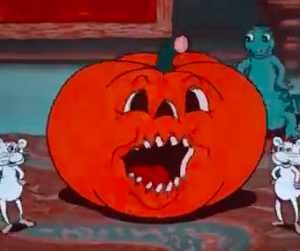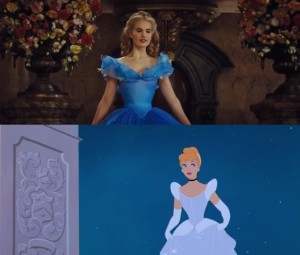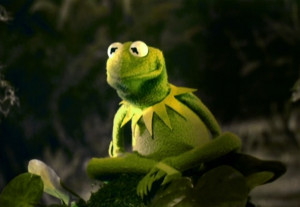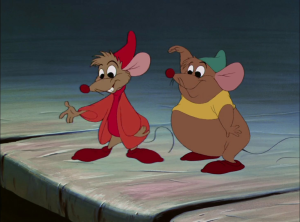When Cinderella is adapted into other mediums, especially when these adaptations are intended for children or families, the animals barely in the original tale become sidekicks with a lot more screen-time. So what happens when you take a plot point and turn it into a character? You give it the ability to make choices within the story — you give it agency.
Betty Boop’s Poor Cinderella is, for my purposes, the first time these animals are given any characterization. And by characterization I mean the ability to sing an absurdly silly song about being free. I have chosen to interpret this musical number as a confirmation of sentience.

The mice and lizards obviously have some idea of what choice means, or else why would they be so passionate about freedom? They seem to exercise their agency by rolling the singing pumpkin into the street, apparently knowing they are about to be turned into something else. There’s not much in the way of motivations or distinct characters for these very brief sidekicks, but there’s only so much you can expect from a 10 minute cartoon. As the short first premiered in 1934 (it’s a very early example in the Fairy Tales and TV Database), there’s a very real possibility this choice to characterize these specific aspects of the original tale were picked up by other adaptations. I think it is also important to note that Betty Boop cartoons, especially those done by the Fleischer brothers in the 1930s, often gave random elements of the story human characteristics for little reason. Poor Cinderella, in all likelihood, accidentally started a trend of giving Cinderella sidekicks without realizing it.

The obvious place to look when talking about sidekicks in Cinderella is Disney’s Cinderella. And while this is a fairy tales and television project, I think it’s important to include the classic film and the reimagining in 2015 and their relationship to the characters they’ve created. It’s very easy to see the agency of the 1950 mice, as they spend the first half of the film with essentially the same amount of deliberate choices as Cinderella. Though despite this control they initially possess, during the iconic transformation scene it is clear they have absolutely no idea what is going on, though seem to be relatively fine with the entire situation once it has happened. Still, there agency no longer matters after this point, whatever personalities they have developed have to be moved aside to make room for the fairy tale.
In the 2015 remake, the mice are portrayed much more realistically. They have a certain amount of presence in the film, but by no means do they have the amount of characterization or level of agency that their earlier counterparts did. The react to the spell in basically the same way as the 1950 film, running away from the strange force, but returning once fully transformed, apparently understanding their new role in the story. Interestingly, they do seem to gain some level of agency after the transformation, the we are shown a deliberate choice between food and opening a window, which is ultimately what saves this Cinderella.
The only real sidekick in the Muppetland TV special Hey Cinderella! is Kermit, and the Fairy Godmother does something different in terms of the transformation as well: she explains the situation. This finally places the choice of whether to go through what must be a terrifying and worldview-altering transformation in the hands, or flippers in this case, of the one it will affect. And when given this choice, he says no.

While this version straddles the line between parody and sincerity, Kermit is given more agency and breadth of choice than any other sidekicks, likely because he is the Muppet: he may not be the central character in this story, but he is the lead in the franchise. Because he is identifiable as a character from outside the tale, he gets to make choices about his role within it.
When these side characters are turned into full sidekicks, suddenly there’s a lot more they can do within the narrative, including demonstrating their own agency. However, the animals to be transformed still need to fulfill this narrative as their original roles, even if it goes contrary to their new available choices. They can’t be the active agent in their story, because they were always a part of someone else’s story.
Real quick: Hi! I’m Gigi Valentine, I’ve just joined the Fairy Tales and TV project and am super excited to be working with very smart people about a subject I’ve always been a little overly-fascinated with. This post is adapted from an essay I wrote in Dr. Rudy’s Late-Summer Honors course about fairy tales, agency, and media, which is why it is not completely about television. Hope you’ll excuse that detail!

Leave a comment